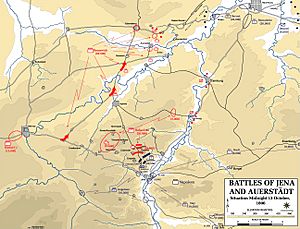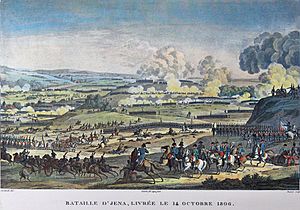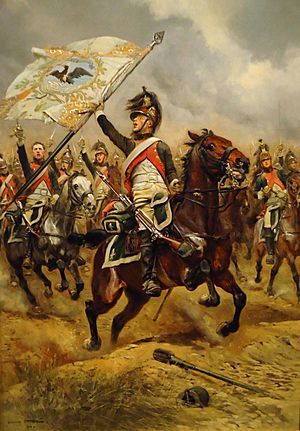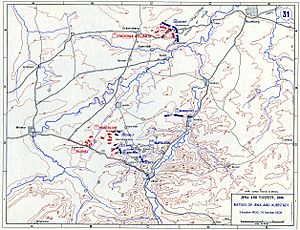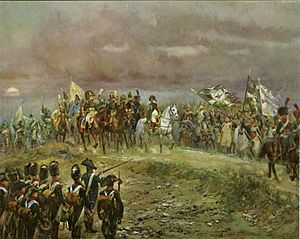Battle of Jena–Auerstedt facts for kids
Quick facts for kids Battle of Jena–Auerstedt |
|||||||||
|---|---|---|---|---|---|---|---|---|---|
| Part of the War of the Fourth Coalition | |||||||||
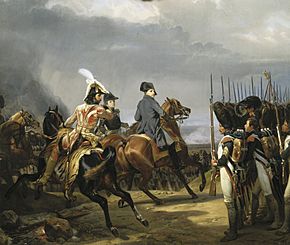 Napoleon rebukes a Grenadier of his Imperial Guard, who according to legend, eager to join the battle, shouted "en avant!" – "forward!" – during the battle of Jena. By Horace Vernet, 1836 |
|||||||||
|
|||||||||
| Belligerents | |||||||||
|
|||||||||
| Commanders and leaders | |||||||||
|
|
||||||||
| Strength | |||||||||
| 40,000 deployed to do battle (Jena) 26,000 (Auerstedt) |
55,000 (Jena) 64,000 (Auerstedt) |
||||||||
| Casualties and losses | |||||||||
| 5,000–6,000 (Jena) 7,052–7,100 (Auerstedt) Total: 12,600 killed, wounded, missing or captured (1,000 Killed in action) |
26,000–27,000 (Jena) 13,000–15,000 (Auerstedt) Total: 41,000 killed, wounded, missing or captured |
||||||||
The Battles of Jena and Auerstedt were two important battles fought on the same day, October 14, 1806. They took place in what is now Germany. The battles were between the French army led by Napoleon I of France and the Prussian army.
The French victory was a big blow to the Kingdom of Prussia. It meant that Prussia was controlled by the First French Empire until 1813. Many important figures who later helped reform the Prussian army fought in these battles. These included Gebhard Leberecht von Blücher, Carl von Clausewitz, and Gerhard von Scharnhorst.
Contents
What Led to the Battles?
After Prussia declared war, Napoleon began his military plan. He moved his large army of 180,000 soldiers through the Frankenwald forest. The Prussian army, with about 130,000 Prussians and 20,000 Saxons, waited for Napoleon.
The Prussian army was not well-organized. They were slower than the French. Their communication was also not as good. This gave the French a big advantage.
How the Battles Unfolded
The battles started when parts of Napoleon's army met Prussian troops near Jena. Napoleon quickly gathered more soldiers, reaching 96,000 men. However, only about 40,000 actually fought. The Prussians were slow to understand what was happening. They were even slower to react.
Meanwhile, further north at Auerstedt, Marshal Louis-Nicolas Davout faced the main Prussian army. This force had 64,000 soldiers, including the Prussian King. Davout's smaller army of 26,000 was outnumbered. But his soldiers were very well-trained. They fought bravely and eventually made the Prussians retreat.
Marshal Bernadotte was nearby but did not join Davout. He followed older orders to go to a different location. This decision was very controversial later on.
Battle of Jena: Napoleon's Victory
Planning the Attack
The Prussian army was split into three groups. A big problem for Prussia was its confusing command system. Several officers shared important roles, like chief of staff. This caused delays and made planning difficult. The Prussians had many plans, but they were always reacting to Napoleon.
Napoleon wanted to force Prussia into a decisive battle, like Austerlitz. He had a large part of his army, called the Grande Armée, in southwest Germany. He decided to advance northeast into Saxony and then to Berlin.
Fighting at Jena
The battle started on the morning of October 14, 1806. French forces attacked the sides of the Prussian lines first. This gave the main French army time to get into position. General Louis-Vincent-Joseph Le Blond de Saint-Hilaire broke through the Prussian left side.
Marshal Michel Ney then attacked the Prussian line without orders. His attack was successful at first. But he went too far forward and faced heavy Prussian artillery fire. The Prussian general ordered a counterattack. Ney's forces were surrounded.
Napoleon saw Ney's trouble. He ordered Marshal Jean Lannes to help Ney. This left the French center weak. But Napoleon used his special Imperial Guard to hold the line. Napoleon was good at adapting his plans during battle. The Imperial Guard helped Ney's units retreat.
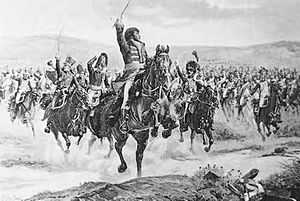
The Prussians did not take advantage of the French weakness. Their infantry stayed still, facing artillery fire. One Prussian general wrote about the "terrible blood-letting and slaughter." Around 1 p.m., Napoleon ordered his forces to push hard. They broke through the Prussian sides and surrounded the main army. The Prussian army had to retreat. Napoleon had won. The Prussians lost 10,000 men killed or wounded. They also had 15,000 prisoners and lost 150 cannons.
Battle of Auerstedt: Davout's Stand
General Étienne Gudin's Division started moving before 6:30 a.m. A heavy fog lifted as they neared Poppel. Prussian cavalry and artillery stopped them. When Marshal Davout saw the Prussian force, he ordered Gudin to set up his troops at Hassenhausen.
The Prussian commander, Friedrich Wilhelm Carl von Schmettau, was ordered to block Davout's advance. As Schmettau's troops prepared to attack, Gebhard Leberecht von Blücher arrived with his cavalry. They attacked Gudin's troops and pushed them back.
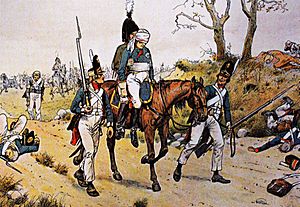
More Prussian forces arrived, led by the Duke of Brunswick. The French cavalry and artillery also arrived. The French forces pushed Blücher's cavalry back. The Duke of Brunswick ordered a full attack on Hassenhausen. Shortly before 10 a.m., the Duke of Brunswick was badly wounded and carried from the field. Schmettau was also badly hurt.
With both commanders out, the Prussian command broke down. The Prussian army was in danger of falling apart. More Prussian troops arrived, but the King made a decision to split their forces. On the French side, more troops arrived to help Davout. Davout saw the Prussians weakening. At 11 a.m., he ordered his infantry to attack.
By noon, the Prussian center was broken. Blücher's cavalry was exhausted. The Prussians realized they had lost. The King ordered a retreat. Davout's army lost about 7,000 soldiers. The Prussians lost about 13,000.
What Happened Next?
Napoleon first found it hard to believe that Davout's army had defeated the main Prussian force alone. He praised Davout greatly, making him the Duke of Auerstedt.
Bernadotte's lack of action was a big topic of discussion. He had orders to be in a different place. He did not believe the main Prussian army was at Auerstedt. He followed Napoleon's earlier orders. This meant he did not help Davout. Later, Napoleon was very angry about Bernadotte's actions.
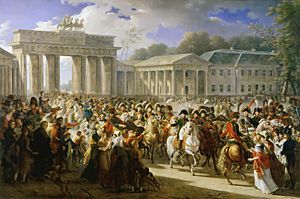
On the Prussian side, the Duke of Brunswick died from his wounds. The remaining Prussian forces could not stop the French cavalry. Many Prussian troops surrendered on October 16. Bernadotte later defeated another Prussian army. Davout was given the honor of entering Berlin first on October 25. Other Prussian forces surrendered in the following days.
By November, only 21,000 Prussian troops remained. Bernadotte, Murat, and Soult chased them relentlessly. The Prussians tried to cross into neutral Denmark, but the Danes blocked them. They then entered the city of Lübeck. However, they were surrounded and defeated in the Battle of Lübeck. Blücher surrendered on November 7. The Siege of Magdeburg also ended with a French victory.
The battles showed how important good command is. Even with some confusion, Napoleon's army won a huge victory.
Lasting Impact
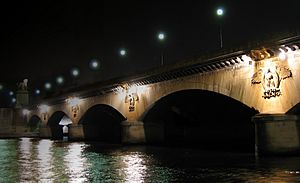
These battles showed Prussia that it needed to change. Important Prussian reformers like Gerhard von Scharnhorst, August von Gneisenau, and Carl von Clausewitz fought there. Their work helped transform Prussia into a modern state. This later helped Prussia lead the effort to remove France from Germany.
The German philosopher Georg Wilhelm Friedrich Hegel was in Jena during the battle. He is said to have finished his famous book, Phenomenology of Spirit, while the fighting happened.
Napoleon built a bridge in Paris to remember the Battle of Jena. After Napoleon's defeat, Prussian soldiers wanted to destroy the bridge. It was temporarily renamed to stop them. A metro station in Paris also has the same name.
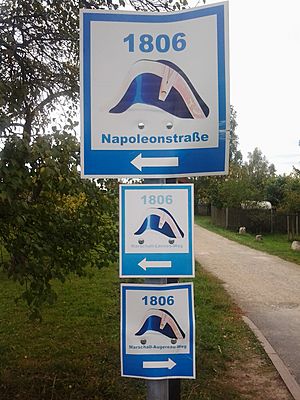
Near Jena, there are hiking trails named after Napoleon and his marshals. In Cospeda, there is a museum about the battle. On October 14, 2006, the battle was re-enacted with 1,800 participants. Every five years, larger events are held to remember the battle.
See also
 In Spanish: Batalla de Jena para niños
In Spanish: Batalla de Jena para niños
- Military career of Napoleon Bonaparte


